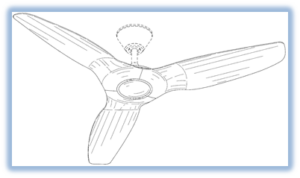Before the court, in this case concerning design patent infringement, was a motion in limine to preclude Defendants’ witnesses from testifying about expense deductions from net profits that are not tied specifically to the sales of the products at issue. In its decision, the court denied the motion, stating that this calculation is “not prejudicial, confusing, or misleading.” Opinion at 7.

Plaintiff Delta T accused Defendants Dan’s Fan City and TroposAir (“Defendants”) of infringing three patented designs of a modern residential ceiling fan. As the case was nearing trial, the parties moved to exclude the introduction of various arguments and evidence at trial. The motion in limine of relevance, here, covered expense deductions. Defendants intended to calculate the amount of fixed costs associated with the sales of the fan by multiplying their total fixed costs by the ratio of their fan sales to their total sales. Plaintiff argued that such “across-the-board” calculation is inadmissible because Defendants did not demonstrate that their “overhead (or other comparable expenses) would have been any different had they not been selling the infringing goods[.]” Dkt. 163 at 8 (emphasis in the original). Defendants countered that it is for the jury to decide which expenses should be considered in determining their profits[1] and that Plaintiff may challenge the calculation at trial.
The patent owner bears the burden of proving damages. BIC Leisure Prods., Inc. v. Windsurfing Int’l, Inc., 1 F.3d 1214, 1217 (Fed. Cir. 1993). “If the plaintiff satisfies this burden of production, the burden shifts to the defendant to come forward with evidence . . . of a different profit calculation, including any deductible costs.” Apple Inc. v. Samsung Elecs. Co., 2017 WL 4776443, at *12 (N.D. Cal. 2017). The district court concluded that “[n]either case law nor logic provides a clear rule for the proper treatment of fixed expenses in computing an award for profits.” (quoting Schnadig Corp. v. Gaines Mfg. Co., 620 F.2d 1166, 1172 (6th Cir. 1980)). The court further stated that because Plaintiff has not provided any authority requiring that Defendants’ calculation of fixed costs be excluded because it is based on an “across-the-board” calculation, the court found the calculation to be appropriate, thereby denying the requested relief.
[1] Under current design law, design patent infringers are “liable to the [patent] owner to the extent of his total profit,” regardless of how much value the patented design added to the product. 35 U.S.C. § 289 (emphasis added), unlike utility patent damages, which are grounded in the value added by the patented feature.
